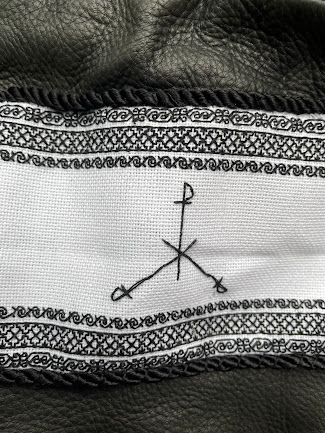Down the Rabbit Hole.
I have fallen down the rabbit hole of research. I spent some time online looking at knit ecclesiastical gloves which has prompted several questions. Some of the religious websites offer interesting information, but not necessarily what I want.
1. I found mention of knitting needles made from either whittled bone or Toledo steel, thought to be approximately less than a millimeter in diameter. Using the size 0000 needles for my funeral pillow was difficult enough. I have a hard time thinking of the knitters’ eyesight from the 16th century—especially since I was working with my glasses off (I’m badly nearsighted) and in bright light. My sympathies go out to those knitters from long ago who were working with sunlight or candlelight.
2. I haven’t been able to uncover any specific meaning yet for the patterns on the gloves. From www.churchtimes.co.uk, I found an article talking about the gloves however that gave some fascinating details.
“Most of the surviving gloves have complex knitted patterns instead, decorating the back of the hand: a sun-burst, a cruciform design, a leafy garland, or the holy letters IHS. Many also have gold bands circling the fingers, to mimic the rings which could be worn by bishops over their gloves. The gauntlets are often intricately trimmed, too, with knitted or embroidered borders, and sometimes finished with tassels.”
But there doesn’t seem to be any rhyme or reason for the different types of banding- different geometric designs could simply be chosen by the maker instead of the Church.
3. The gloves were found to be worn by church officials with the rank or Bishop or higher, specifically for ceremonial use. However, many church officials were buried with a new pair of gloves.
4. One paper talking about a specific pair of gloves that were inspected, state that : “The silk yarn is multi-stranded and the gloves were knitted in the round so that, originally, there were no actual seams, only a false seam on the outer edge of each glove which ran to just before the start of the division for the small finger. The false seam is formed by a purl stitch which, countering the knit stitches of the rest of the glove, adds structure and stability, preventing twisting. At a later date the gloves were altered to make them smaller by taking them in along either side of the false seam.” In persona Christi: Liturgical Gloves and the Construction of Public Religious Identity- published at The University of Manchester, UK. https://pure.manchester.ac.uk/ws/portalfiles/portal/127855249/Warr_Liturgical_Gloves_01_09_19_FINAL.pdf
The paper also stated that: In the sixteenth century the Cardinal Archbishop of Milan Carlo Borromeo (1538-84) issued regulations on ecclesiastical dress in the wake of the Council of Trent. “The bishop’s gloves must be interwoven and prominently decorated on the top with a golden circle.”
But why would there be a false seam when it's so much easier to knit in the round and keep the fabric smooth? And the necessity for a false seam, to add structure and stability, doesn't make a lot of sense to me. This will be something to look into- perhaps one guild vs another added the seam to differentiate from one another?


Comments
Post a Comment